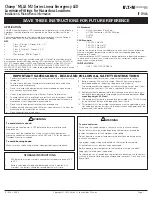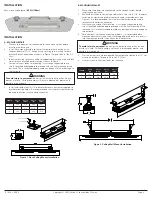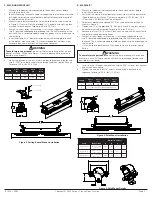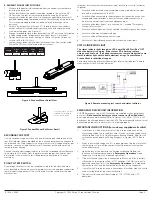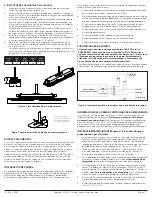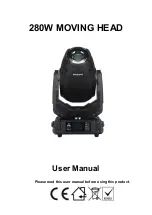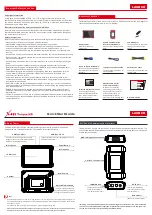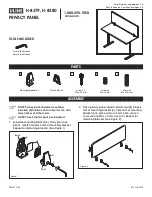
MAINTENANCE
GENERAL
Important Notes: Branch circuit field wiring must be disconnected prior
to initial luminaire installation or maintenance. Before performing any
maintenance work with the luminaire enclosure open, the battery pack
must be disconnected from the converter/inverter assembly by separating
the latching connectors (connecting two white wires and two black and
red wires of battery). Also disconnect battery/converter connector (Red-
Red wires). See Figures 14A, 14B and 14C for connection location.
1. Disconnect the battery/converter connector during extended periods of
power loss of more than 1 week.
2. If luminaire is out of service for more than 1 year, perform annual test
procedure & replace battery packs as needed.
3. Perform visual, electrical and mechanical inspections on a regular basis.
The environment and frequency of use should determine this. However,
it is recommended that checks be made at least once a year. We
recommend an Electrical Preventive Maintenance Program as described
in the National Fire Protection Association Bulletin NFPA No. 70B:
Recommended Practice for Electrical Equipment Maintenance (www.
nfpa.org)
4. The lens should be cleaned periodically to ensure continued lighting
performance. To clean, wipe the lens with a clean, damp cloth. If this is
not enough, use a mild soap or a common liquid cleaner. Do not use an
abrasive, strong alkaline or acid cleaner. Damage may result.
5. Visually check for undue heating evidenced by discoloration of wires or
other components, damaged parts or leakage evidenced by water or
corrosion in the interior. Replace all worn, damaged or malfunctioning
components, and clean gasket seals before putting the luminaire back into
service.
6. Electrically check to make sure that all connections are clean and tight.
7. Mechanically check that all parts are properly assembled.
8. Check and re-torque all mounting hardware.
9. To prevent heat build-up, remove dust from the LED housing using a soft
brush or air pressure.
10. Visually inspect status indicator (charging) indicator light monthly. It
should be illuminated (when AC power ON). If indicator is flashing contact
tech support.
11. Test the emergency operations of the luminaire at 30-day intervals for
a minimum of 30 seconds. The LED load should operate at reduced
illumination in case of power failure
12. Conduct a 90 minute discharge test once a year. The LED load should
operate at reduced illumination for at least 90 minutes.
REPLACEMENT PARTS
(USE LISTED FITTINGS COVERED - LED DRIVERS,
MOUNTING OPTIONS, LED LIGHT ENGINE)
Eaton’s Crouse-Hinds series Champ Linear Emergency LED luminaires are
designed to provide years of reliable lighting performance. However, should
the need for replacement parts arise, they are available through your authorized
Eaton’s Crouse-Hinds distributor. Assistance may also be obtained through your
local Eaton’s Crouse-Hinds representative or the Eaton’s Crouse-Hinds Sales
Service Department, 1201 Wolf Street, Syracuse, New York 13208, Phone
866-764-5454.
All statements, technical information and recommendations contained herein are based on information and tests we believe to be reliable. The accuracy or completeness thereof are not
guaranteed. In accordance with Eaton’s Crouse-Hinds Division’s “Terms and Conditions of Sale,” and since conditions of use are outside our control, the purchaser should determine
the suitability of the product for his intended use and assumes all risk and liability whatsoever in connection therewith.
Eaton’s Crouse-Hinds Division
IF 1946
1201 Wolf Street Syracuse, NY 13208 • U.S.A.
Revision 1
Copyright© 2022
New 09/22
Figure 14C. UNV1 w/Surge Option Wiring Diagram

